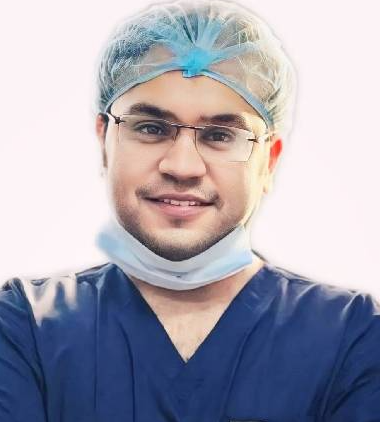Embolization: Treat Aneurysms and Bleeding

Treatment Duration
30 Minutes
------ To ------40 Minutes
Treatment Cost
₹ 50,000
------ To ------₹ 1,98,000

Table of Contents
- What is Endovascular embolisation?
- Anatomy and Physiology of Brain
- Conditions Treated with endovascular embolisation
- Who needs Endovascular Embolization Surgery?
- How is Endovascular Embolization Surgery performed?
- What to Expect Before and On the Day of Endovascular Embolization Surgery?
- What to Expect After Endovascular Embolization Surgery?
- Risks and complications of Endovascular Embolization Surgery
- Risks of delayed Endovascular Embolization Surgery
- Cost of Endovascular Embolization Surgery
Endovascular embolisation is an invasive procedure used to treat blood vessels that are not normal. These blood vessels can be either in the brain or in other body parts. This treatment focuses on restricting the bleeding and decreasing the pressure on the affected body part. In Endovascular embolisation, the bleeding is stopped by cutting the blood supply to the bleeding artery or blood vessel during a haemorrhage stroke. Embolic substances such as tiny spheres, metal coils, or glue may be used to block the artery or blood vessel that is affected.
You can check Endovascular Embolization Cost here.
What is Endovascular embolisation?
Endovascular embolisation is an invasive procedure used to treat blood vessels that are not normal. These blood vessels can be either in the brain or in other body parts. This treatment focuses on restricting the bleeding and decreasing the pressure on the affected body part. In Endovascular embolisation, the bleeding is stopped by cutting the blood supply to the bleeding artery or blood vessel during a haemorrhage stroke. Embolic substances such as tiny spheres, metal coils, or glue may be used to block the artery or blood vessel that is affected.
Expert Doctors (10)
NABH Accredited Hospitals (10)


Anatomy and Physiology of Brain
Endovascular embolisation is primarily used for the management of brain aneurysms. An aneurysm is a condition in which the patient develops ballooning or bulging inside the vessels of the brain. As a result, the patients are at increased risk for developing a rupture or leak, resulting in the development of hemorrhagic stroke. Most brain aneurysms have no symptoms and are diagnosed when evaluating the brain for other conditions. The symptoms, if present, may include severe headache, seizures, nausea and vomiting, confusion, drooping eyelid, and sensitivity to light.
Conditions Treated with endovascular embolisation
Endovascular embolisation is used to treat the following medical conditions where open surgery is not recommended:-
- Arteriovenous malformation (a condition in which the blood vessels that connect the arteries and veins get tangled)
- A brain aneurysm (bulge in the blood vessel of the brain)
- Arteriovenous fistula (abnormal association between the artery and vein)
- Certain types of tumours, such as neck and head tumours
- Carotid artery cavernous fistula (a condition in which the artery of the brain is enlarged)
- Uterine fibroid (non-cancerous growth of the tissues of the uterus)
- It is also used to treat excessive nose bleeding
Who needs Endovascular Embolization Surgery?
The right candidate for Endovascular Embolization Surgery is anyone with abnormal blood vessels found in any part of the body including the brain.
How is Endovascular Embolization Surgery performed?
- The staff connects you with the echocardiogram that records the heart's activity. Your vital signs, such as your breathing rate, heart rate and blood pressure, and neurological symptoms will be recorded throughout the surgery.
- First of all, an anesthesiologist will inject a precise dose of anaesthesia into the patient.
- As the complete procedure is done under the effect of anaesthesia, the patient will not feel any kind of pain during surgery.
- The surgeon will make a tiny incision in the groin region of the patient and insert a catheter (a long thin tube) into the large blood vessel of the leg known as the femoral artery.
- The catheter is guided by an imaging monitor, which continuously shows the image of the blood vessel and the location of the catheter.
- The imaging monitor runs on the principle of X-ray.
- When the catheter has reached the site of the abnormality, then the embolisation materials that seal the blood vessels and block blood supply at the aneurysm site are injected through the catheter into the blood vessels.
- These embolisation materials may be of different types, such as:-
- Biologically inert glue that does not interact with the body
- Tiny particles of plastics
- Surgical balloons may also be used to block the artery or vein.
During Endovascular Embolization Surgery
During the surgery, the team of doctors will be present, along with the nurses and staff helpers.
- All the vitals, like blood pressure, heart rate, pulse rate, and blood oxygen level, are continuously monitored during the whole procedure.
- The anesthesiologist will continuously monitor the effect of anaesthesia during the whole surgery time. Therefore, keeping the patient in an anaesthetic state during the procedure is important.
What to Expect Before and On the Day of Endovascular Embolization Surgery?
The doctor/surgeon will discuss and prepare the patient for the surgery.
Before Endovascular Embolisation Surgery
- The procedure generally takes about 30 minutes, and you may be asked to lie in a supine position (face towards the roof) or prone (face towards the floor), depending upon the type of endovascular embolization procedure.
- Endovascular embolisation requires a proper checking of the medical history of the patient.
- All physical checkups must be done within 30 days before the surgery.
- The doctor may also advise the patient to empty the bladder before the surgery.
- The tests that require blood samples must be done before 14 days of the surgery.
- Blood tests are advised to evaluate the following parameters in the blood:
- Creatinine
- Platelets
- Haemoglobin
- Potassium
- Sodium
- Avoid eating and drinking anything before 6 hours of the surgery.
- If you are not on fluid restriction by your doctor, you should drink plenty of fluid before two days of the surgery.
- If any medicines are to be taken, take them in the morning of the surgery day with a small sip of water.
- You should stop taking blood-thinning medicines like aspirin or warfarin at least five days before the surgery.
- You should avoid smoking and drinking before the surgery.
What to Expect on the Day of Endovascular embolization Surgery?
- You should not:
- Drink anything after midnight of the surgery
- Arrive at the hospital in loose-fitting and comfortable clothes.
- Take the jewellery, piercings, and valuables to the hospital.
- You may also be asked to remove the contact glasses before the surgery.
- Try to reach the hospital before the surgery time.
- The hospital staff will then ask for your name, age, and father's name. It is done to minimise the risk of cross-matching of patients.
- Hospital staff will then tie a band on the wrist of the patient. It is done to recognise the candidates for the surgery.
What to Expect After Endovascular Embolization Surgery?
- After completing the surgery, generally, you will have to spend 1 or 2 days in the hospital. However, the time may differ depending upon the severity of the case and your recovery.
- The surgeon may also remove the catheter once the seal is complete and there is no bleeding.
- The doctor will also prescribe some painkiller medicines to reduce the pain caused after the surgery.
- It is advised to the patients to drink plenty of fluids in the next 3 to 4 weeks. It will help in preventing headaches caused after the surgery.
- You should avoid lifting heavy objects for a few days.
- Always try to keep the site of the incision dry.
- The recovery rate depends upon the general health and the intake of medications prescribed by the doctor. So, it is necessary to take medicines on time and keep yourself healthy after the surgery.
First follow-up appointment
- You will be asked to come for a follow-up appointment after six months of surgery.
- You can expect to have a cerebral angiogram during this follow-up appointment if this treatment was done to treat the brain aneurysm.
- The doctor may recommend various tests, including blood tests or imaging tests, to know your overall health.
Risks and complications of Endovascular Embolization Surgery
Although the problems after the surgery are very minimal, you should still immediately contact your doctor if you experience the below signs and symptoms:-
- Re-occurrence of the symptoms of the associated condition.
- Bleeding from the incision site.
- Damage to the artery with a catheter inserted during the surgery
- An infection at the incision site or anywhere else in the body
- If the blocking material used has failed after the surgery
- Seizures
- Confusion
Other conditions associated with the dose of general anaesthesia in which you should call the doctor without any delay are:-
- Lung infection
- Heart attack
- Stroke
Risks of delayed Endovascular Embolization Surgery
If the surgery is delayed, then the patient may experience the following:-
- The aneurysm in the brain may rupture or leak.
- There are chances of vasospasm in the blood vessels in the brain.
- If not treated for a long time, the condition may also lead to serious cardiac arrhythmia, heart failure, and myocardial infarction.
Cost of Endovascular Embolization Surgery
The cost of Endovascular Embolization Surgery ranges from ₹50,000 to ₹1,98,000. The cost varies based on some of the following factors:
- Age of the patient
- Site or organ where the procedure done
- The medical condition of the patient
- The type of hospital facility availed - individual room or shared.
More Treatment options
Last Updated on: 13 October 2025
Author
HexaHealth Care Team
HexaHealth Care Team brings you medical content covering many important conditions, procedures falling under different medical specialities. The content published is thoroughly reviewed by our panel of qualified doctors for its accuracy and relevance.
Endovascular Embolization Cost in Top Cities
Latest Health Articles























